CHEVROLET TRACKER 1997 Owners Manual
Manufacturer: CHEVROLET, Model Year: 1997, Model line: TRACKER, Model: CHEVROLET TRACKER 1997Pages: 388, PDF Size: 20.12 MB
Page 211 of 388
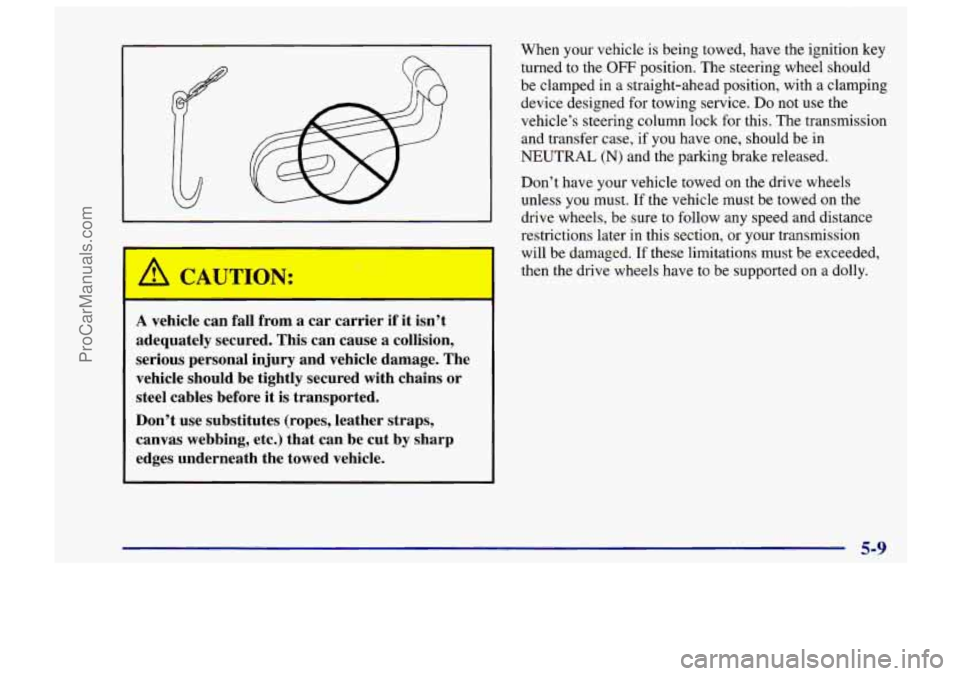
A vehicle can fall from a car carrier if it isn’t
adequately secured. This can cause
a collision,
serious personal injury and vehicle damage. The
vehicle should be tightly secured with chains or
steel cables before it
is transported.
Don’t use substitutes (ropes, leather straps,
canvas webbing, etc.) that can be cut by sharp
edges underneath the towed vehicle.
When your vehicle is being towed, have the ignition key
turned to the
OFF position. The steering wheel should
be clamped in a straight-ahead position, with a clamping device designed for towing service.
Do not use the
vehicle’s steering column lock for this. The transmission
and transfer case, if you have one, should
be in
NEUTRAL (N) and the parking brake released.
Don’t have your vehicle towed on the drive wheels
unless you must. If the vehicle must be towed on the
drive wheels, be sure to follow any speed and distance
restrictions later in this section,
or your transmission
will be damaged.
If these limitations must be exceeded,
then the drive wheels have to be supported on a dolly.
5-9
I
ProCarManuals.com
Page 212 of 388
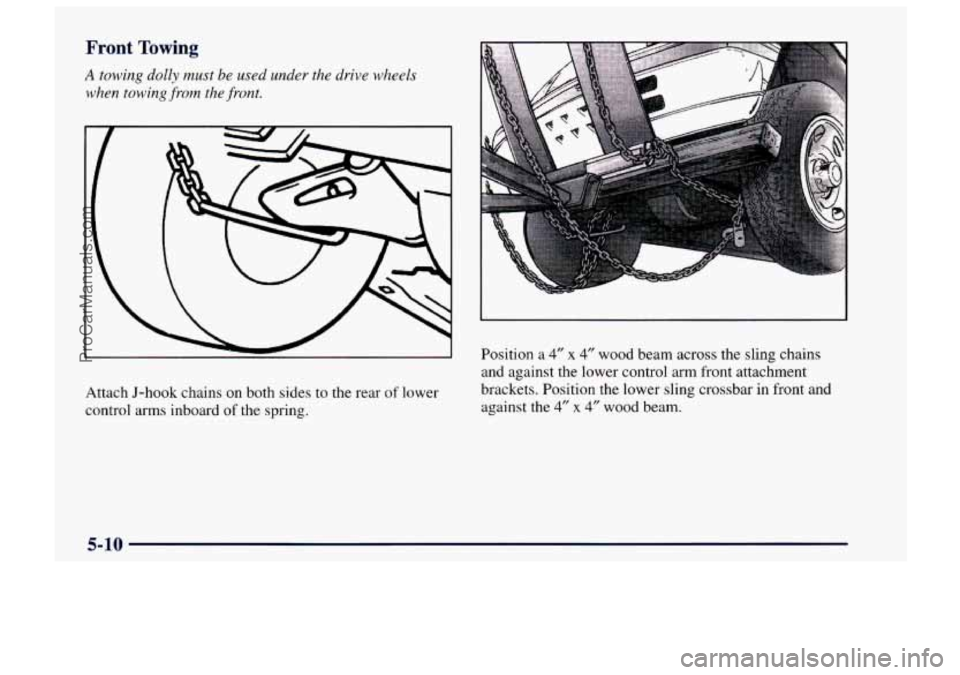
Front Towing
A towing dolly must be used under the drive wheels
when towing
from the front.
Attach J-hook chains on both sides to the rear of lower
control arms inboard of
the spring. Position
a
4” x 4” wood beam across the sling chains
and against the lower control arm front attachment
brackets. Position the lower sling crossbar in front and
against the
4” x 4” wood beam.
5-10
ProCarManuals.com
Page 213 of 388
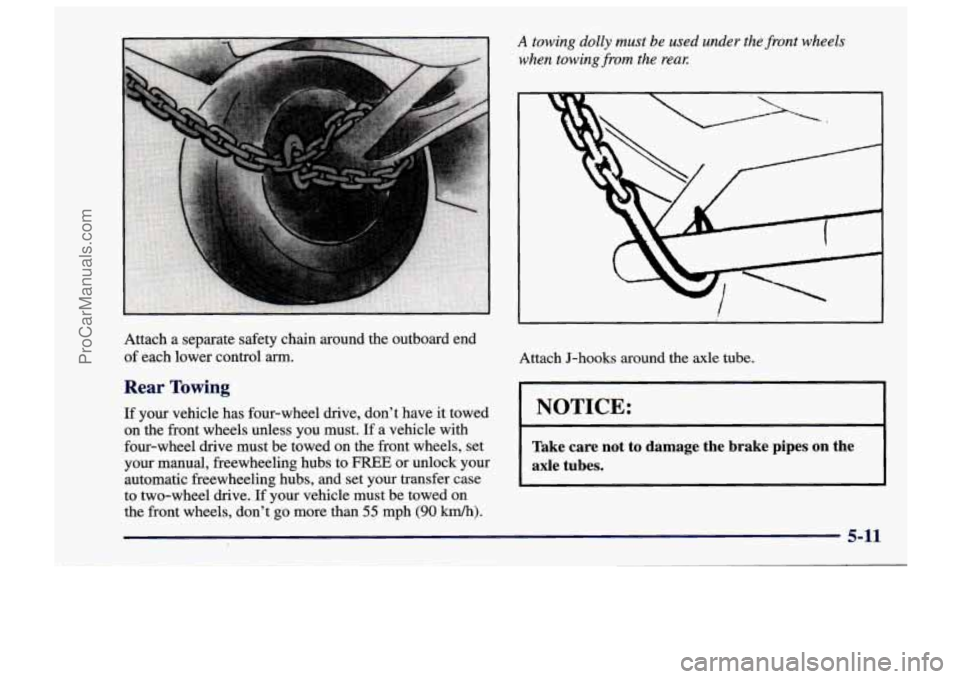
Attach a separate safety chain around the outboard end
of each lower control arm.
Rear Towing
If your vehicle has four-wheel drive, don’t have it towed
on the front wheels unless you must. If a vehicle with
four-wheel drive must be towed on the front wheels, set your manual, freewheeling hubs to
FREE or unlock your
automatic freewheeling hubs, and set your transfer case
to two-wheel drive.
If your vehicle must be towed on
the front wheels, don’t go more than 55 mph (90 km/h).
A towing dolly must be used under the front wheels
when towing from the real:
Attach J-hooks around the axle tube.
1 NOTICE:
Take care not to damage the brake pipes on the
axle tubes.
ProCarManuals.com
Page 214 of 388
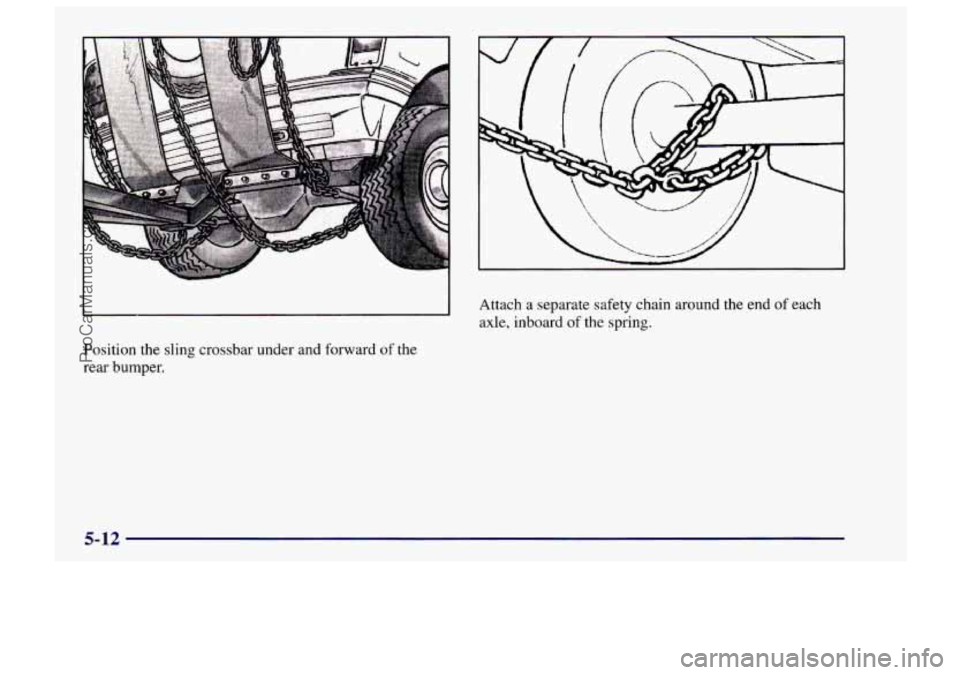
Position the sling crossbar under and forward of the
rear bumper.
L
Attach a separate safety chain around the end of each
axle, inboard
of the spring.
5-12
ProCarManuals.com
Page 215 of 388
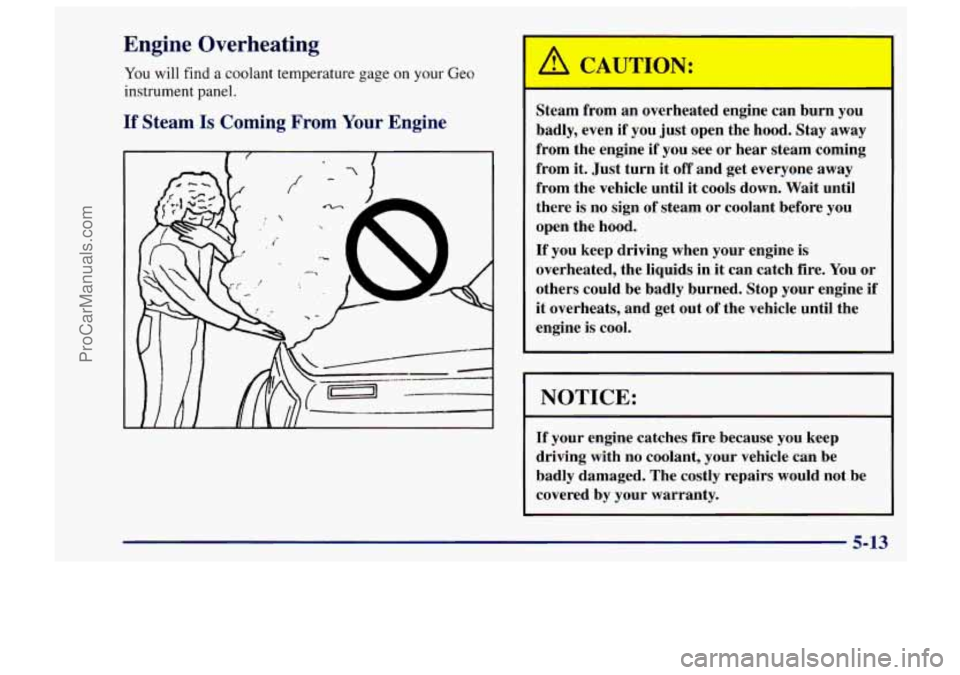
Engine Overheating
You will find a coolant temperature gage on your Geo
instrument panel.
If Steam Is Coming From Your Engine
Steam from an overheated engine can burn you
badly, even if you just open the hood. Stay
away
from the engine if you see or hear steam coming
from it. Just turn it off and get everyone
away
from the vehicle until it cools down. Wait until
there is no sign of steam or coolant before you
open the hood.
If you keep driving when your engine is
overheated, the liquids in it can catch fire. You or
others could be badly burned. Stop your engine if
it overheats, and get out of the vehicle until the
engine is cool.
I NOTICE:
~~~~ ~ ~~
If your engine catches fire because you keep
driving with no coolant, your vehicle can be
badly damaged. The costly repairs would not be
covered by your warranty.
1
5-13
t
ProCarManuals.com
Page 216 of 388
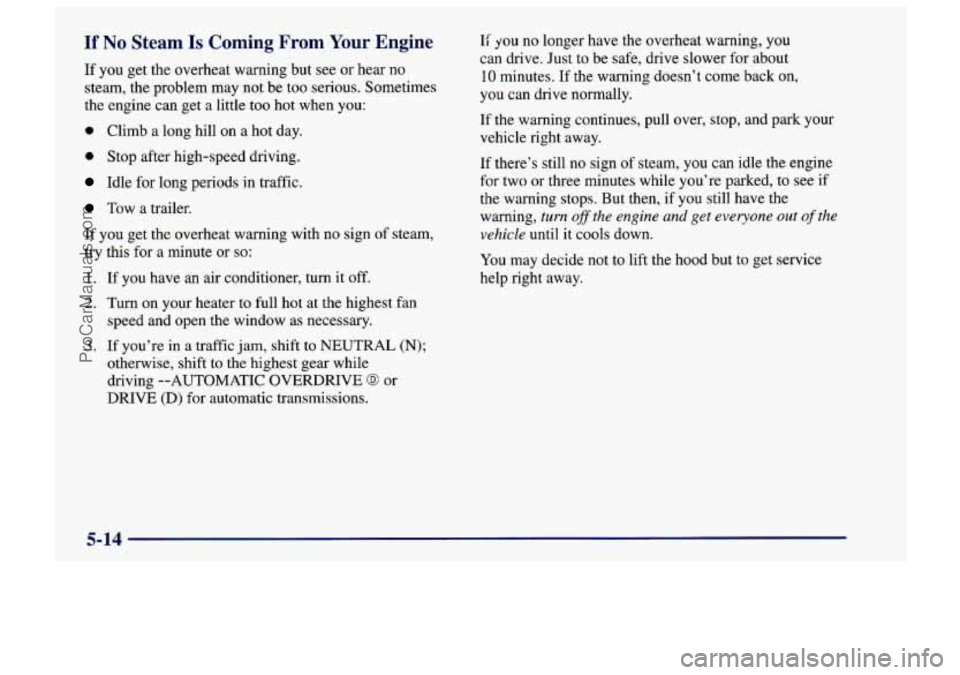
If No Steam Is Coming From Your Engine
If you get the overheat warning but see or hear no
steam, the problem may not be too serious. Sometimes
the engine can get a little too hot when you:
0 Climb a long hill on a hot day.
0 Stop after high-speed driving.
Idle for long periods in traffic.
Tow a trailer.
If you get the overheat warning with no sign of steam,
try this for a minute
or so:
1. If you have an air conditioner, turn it off.
2. Turn on your heater to full hot at the highest fan
speed and open the window as necessary.
3. If you’re in a traffic jam, shift to NEUTRAL (N);
otherwise, shift to the highest gear while
driving --AUTOMATIC OVERDRIVE
0 or
DRIVE (D) for automatic transmissions.
Ii‘ you no longer have the overheat warning, you
can drive.
Just to be safe, drive slower for about
10 minutes. If the warning doesn’t come back on,
you can drive normally.
If the warning continues, pull over, stop, and park your
vehicle right away.
If there’s still no sign of steam, you can idle the engine
for two or three minutes while you’re parked, to see
if
the warning stops. But then, if you still have the
warning,
turn off the engine and get everyone out of the
vehicle
until it cools down.
You may decide not to lift the hood but to get service
help right away.
5-14
ProCarManuals.com
Page 217 of 388
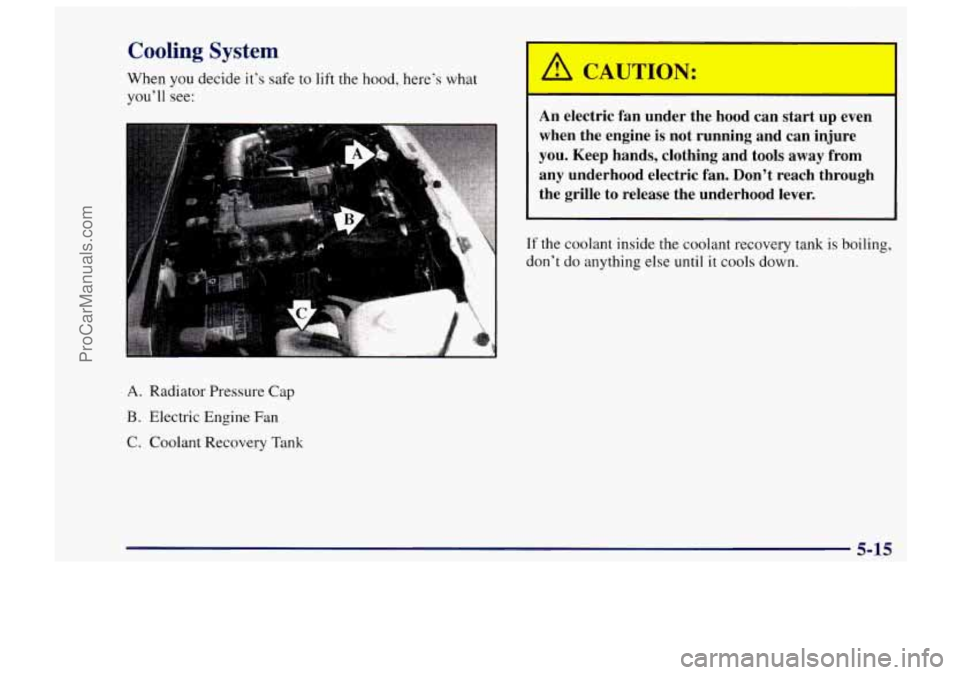
Cooling System
When you decide it’s safe to lift the hood, here‘s what
you’ll see:
A. Radiator Pressure Cap
B. Electric Engine Fan
C. Coolant Recovery Tank
5-15
I
ProCarManuals.com
Page 218 of 388
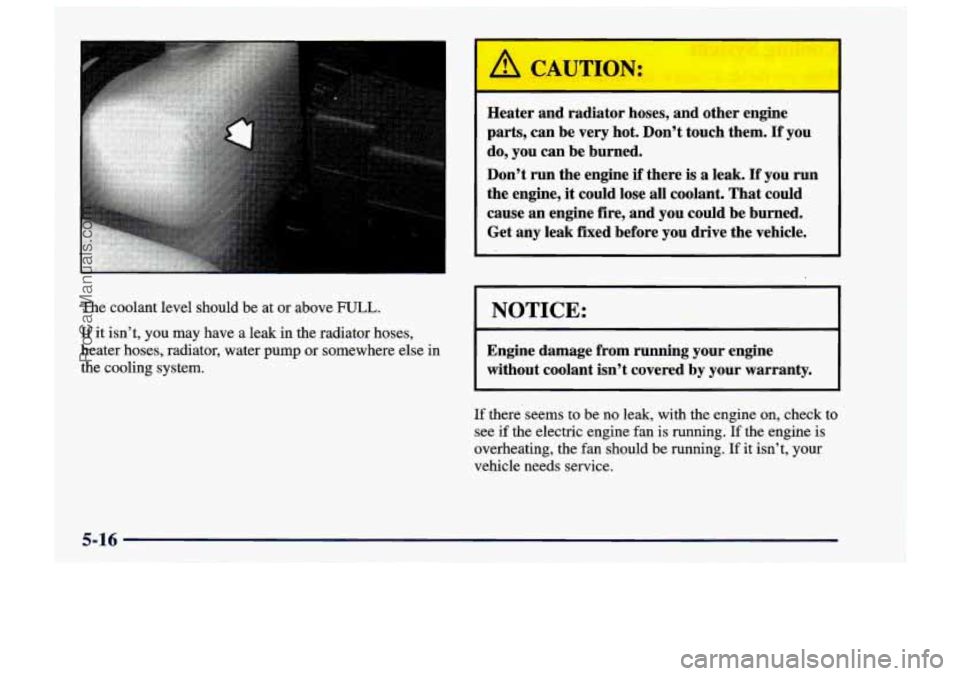
1
The coolant level should be at or above FULL.
If it isn’t, you may have a leak in the radiator hoses,
heater hoses, radiator, water pump or somewhere else in
the cooling system.
I
A CAUTION:
Heater and radiator hoses, and other engine
parts, can be very hot. Don’t touch them.
If you
do, you can be burned.
Don’t run the engine if there
is a leak. If you run
the engine,
it could lose all coolant. That could
cause an.engine fire, and you could be burned.
Get any leak fixed before you drive the vehicle.
I NOTICE:
Engine damage from running your engine
without coolant isn’t covered by your warranty.
If there seems to be no leak, with the engine on, check to
see if the electric engine fan is running.
If the engine is
overheating, the fan should be running.
If it isn’t, your
vehicle needs service.
5-16
ProCarManuals.com
Page 219 of 388
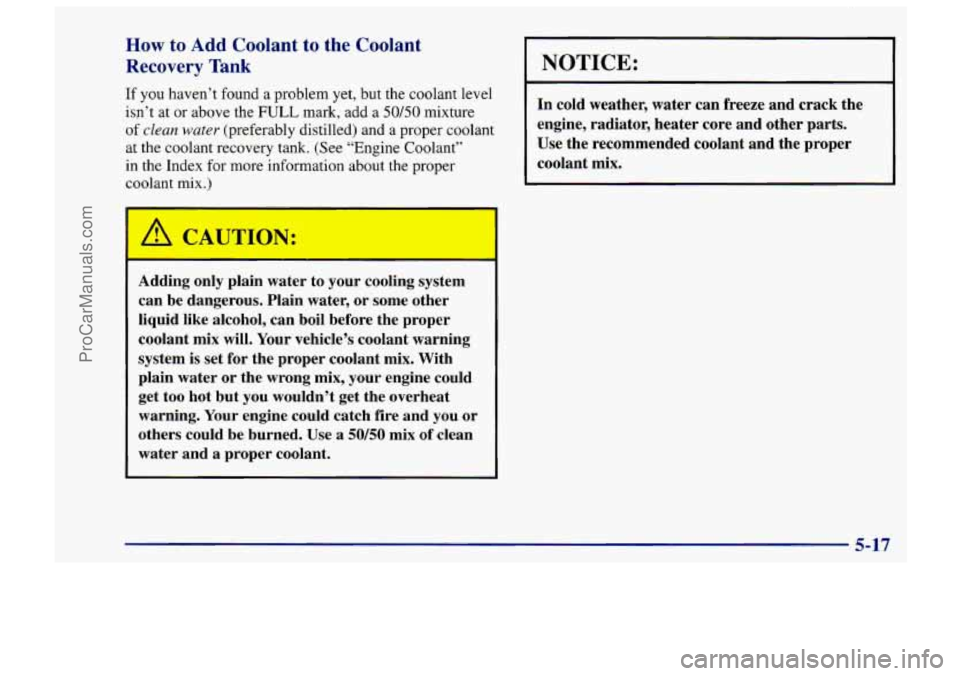
How to Add Coolant to the Coolant
Recovery Tank
If you haven’t found a problem yet, but the coolant level
isn’t at or above the
FULL mark, add a 50/50 mixture
of clean water (preferably distilled) and a proper coolant
at the coolant recovery tank. (See “Engine Coolant’’
in the Index for more information about the proper
coolant
mix.)
Adding only plain water to your cooling system
can be dangerous. Plain water, or some other
liquid like alcohol, can boil before the proper
coolant mix will. Your vehicle’s coolant warning
system is set for the proper coolant mix. With
plain water or the wrong mix, your engine could
get too hot but you wouldn’t get the overheat
warning. Your engine could catch fire and you or
others could be burned. Use a
50/50 mix of clean
water and
a proper coolant.
NOTICE:
In cold weather, water can freeze and crack the
engine, radiator, heater core and other parts.
Use the recommended coolant and the proper
coolant mix.
5-17
I
ProCarManuals.com
Page 220 of 388
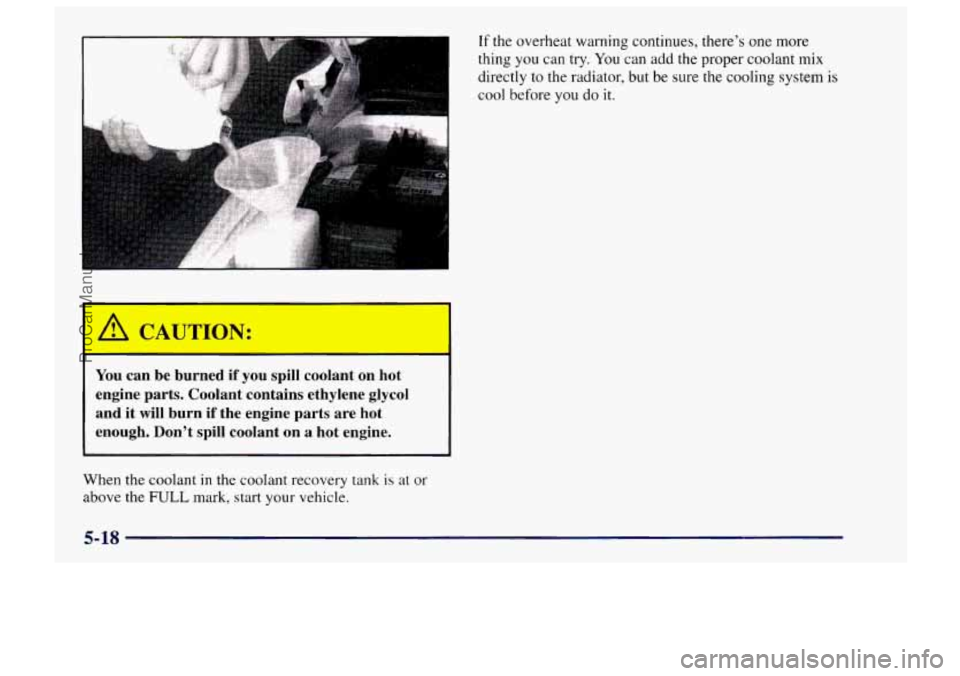
/ CAUTION:
You can be burned if you spill coolant on hot
engine parts. Coolant contains ethylene glycol
and
it will burn if the engine parts are hot
enough. Don't spill coolant on a hot engine.
When the coolant in the coolant recovery tank is at or
above the
FULL mark, start your vehicle.
If the overheat warning continues, there's one more
thing you can try.
You can add the proper coolant mix
directly
to the radiator, but be sure the cooling system is
cool before you do it.
5-18
ProCarManuals.com